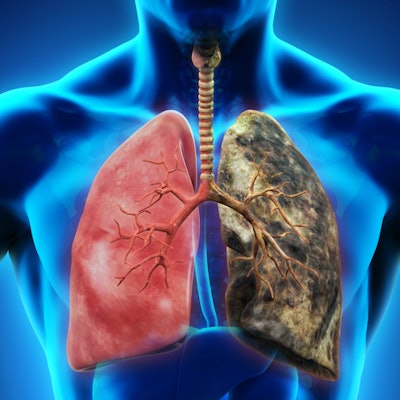
The much-anticipated final results from the Dutch-Belgian Randomized Lung Cancer Screening (NELSON) trial were published online January 29 in the New England Journal of Medicine. The findings reaffirm that CT lung cancer screening can significantly reduce high-risk smokers' likelihood of death from lung cancer.
The large-scale randomized controlled trial investigated the potential benefits of CT lung screening among 15,792 individuals in the Netherlands and Belgium between the ages of 50 and 74 who had a high risk of lung cancer. The researchers found that screening led to a statistically significant reduction in total lung cancer deaths by 24% for men and 33% for women, compared with no screening.
"The NELSON trial showed that volume CT lung cancer screening, with low rates of follow-up procedures for test results suggestive of lung cancer, resulted in substantially lower lung cancer mortality than no screening among high-risk persons," wrote lead author Dr. Harry de Koning, PhD, of Erasmus University Medical Center in Rotterdam, and colleagues.
Preventing lung cancer deaths
Initially announced at the 2018 World Conference on Lung Cancer in Toronto, the trial's preliminary results indicated that CT lung screening led to reductions in lung cancer death rates, reaching 26% in men and nearly 40% in women. These outcomes surpassed the 20% reduction in lung cancer deaths reported in the U.S. National Lung Screening Trial (NLST), which compared the benefits of screening for lung cancer with CT to screening with x-ray.
In the NELSON trial, the researchers randomly assigned participants either to a CT lung screening protocol or no screening. The four-round screening protocol included a baseline CT exam followed by a CT exam at one, three, and five and a half years after the initial exam.
Trial participants were between the ages of 50 to 74, were current or former smokers who quit 10 or fewer years before screening, and had a smoking history of roughly 20 pack years or more. The researchers tracked the participants for at least 10 years following the baseline exam.
After analyzing the full NELSON dataset, the researchers found that the rate of death from lung cancer was lower in the screening group than in the control group by a statistically significant basis -- 24% lower for men and 33% lower for women (p = 0.01). They separated the results by sex since the vast majority of the participants were male (84%).
| Effect of NELSON CT lung cancer screening on mortality after 10 years | ||
| No screening | CT lung screening | |
| Rate of lung cancer death in men per 1,000 person years* | 3.3 deaths | 2.5 deaths |
| Rate of all-cause mortality in men per 1,000 person years | 13.8 deaths | 13.9 deaths |
Overall, the rate ratio for death from lung cancer between the screening and control groups was 0.76 for men and 0.67 for women at 10 years after the initial screening exam, confirming that CT lung screening was effective at preventing lung cancer deaths. The study was not adequately powered to determine statistical difference in all-cause mortality between the two groups.
The researchers also found that CT lung screening increased the likelihood of detecting lung cancer in the early stages: The proportion of cancers detected in stage IA or IB was 58.6% with CT lung screening and only 13.5% for the control group.
No doubt of benefits
In an accompanying editorial, Stephen Duffy, PhD, from Queen Mary University London and John Field, PhD, from the University of Liverpool highlighted several additional observations concerning the NELSON results:
- The intervals between the four screening exams were one year, two years, and two and a half years, compared with the strict one-year intervals in the NLST, demonstrating that lengthening the time between screens to at least two years instead of one was safe and effective.
- Lung cancer mortality began to increase at the same rate for the two groups starting at about two and a half years after the final screening round (or eight years after the initial screening exam) in the NELSON trial and three and half years after final screening in the NLST, which suggests that the protective effect afforded by screening lasts between two and a half years to three and a half years.
- The benefits of CT lung screening were relatively greater for women than men, both in the NELSON trial and NLST, underscoring the need to explore why this difference occurs.
- Overall, 2.1% of the CT scans were true positives and required further workup, with a positive predictive value of 43.5%. The upper threshold for overdiagnosis was 8.9%, and the false-positive rate over all screening rounds was 1.2%.
- The NELSON researchers tracked lung cancer based on nodule volume doubling time. In contrast with the NLST method of measuring nodule diameters, volume-based analysis increased early-stage cancer detection and decreased the rate of indeterminate screening tests requiring a repeat CT scan. The European position statement on lung cancer screening has advocated use of the NELSON team's lung-nodule management system.
The findings show that there can no longer be any doubt as to the efficacy of CT lung screening in reducing lung cancer mortality -- paving the way for its adoption in Europe, Duffy and Field noted.
"Our job is no longer to assess whether low-dose CT screening for lung cancer works: it does," they wrote. "Our job is to identify the target population in which it will be acceptable and cost-effective."
Physicians, regulators must act
Despite the clear benefits of CT lung screening, several barriers remain to more implementation of the test, including challenges with reimbursement set forth by the U.S. Centers for Medicare and Medicaid Services (CMS), according to the American College of Radiology (ACR).
Unlike with breast and colon cancer screening, U.S. physicians must conduct a shared decision-making session with an individual to receive reimbursement. CMS has also lowered Medicare reimbursement for CT lung screening to $60 per exam in the hospital outpatient setting (less than half of the reimbursement amount for a mammogram), making it difficult for facilities to provide the service without incurring a financial loss.
"If implemented nationwide, this cost-effective test would save more lives than any cancer screening test in history," said Dr. Debra Dyer, chair of the ACR Lung Cancer Screening 2.0 Committee, in a statement. "Medicare must provide adequate reimbursement for these exams. Primary care providers and thoracic specialists should order the CTs for their high-risk patients."
Ongoing updates to ACR's Lung-RADS have decreased the rate of false-positive CT lung screening tests by 75% compared with previous studies, addressing concerns over the potential harms of overdiagnosis.
"The massive lifesaving benefit of these exams, and the threat to older current and former smokers from this disease, outweighs any potential harms to the defined screening population," Dyer said. "We must do all we can to ensure patients are appropriately referred and have widespread access to lung cancer screening CT."




















